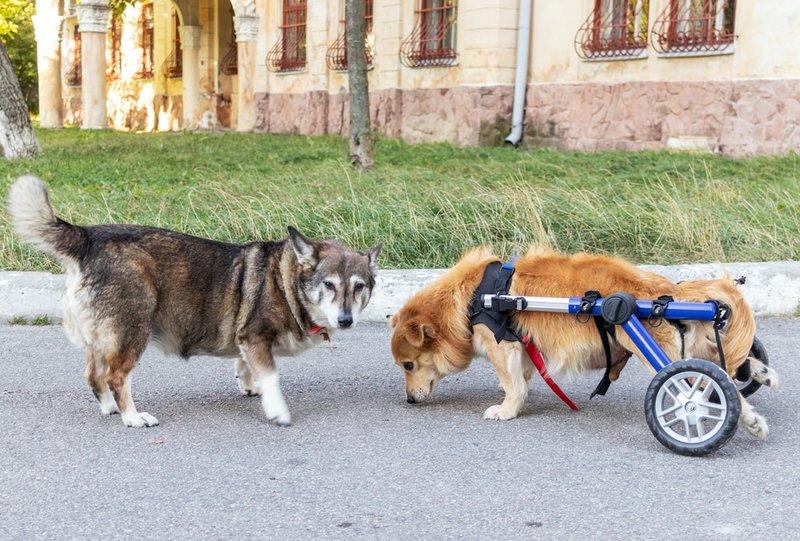We all desire seamless experiences with our pets, whether we say it out or not. So, it can be pretty devastating when we see them suffering from health challenges such as IVDD. Thus, it isn’t strange for you to wonder what this dreaded condition is and what causes it?
IVDD is an acronym for Intervertebral Disc Disease. It is caused by vertebral discs that are bulging, herniated, or slipping on the back of your pooch. IVDD is degenerative, meaning it typically occurs as your dog gets older, and the symptoms can be nerve-wracking. Ranging from severe pain to paralysis, the effects of IVDD are no joke.
So, if you’re looking forward to knowing how to take care of your pooch in this critical condition or how to prevent this from happening, join me as I explain all these and more below.
What Is IVDD?
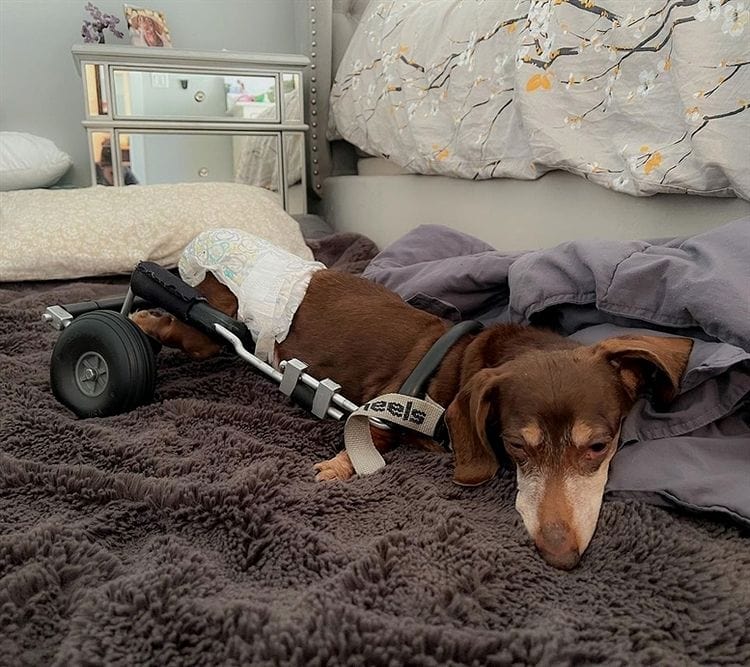
Intervertebral Disc Disease, IVDD, is a condition that affects the spine of the canines. It occurs when one or more discs on the vertebral column of your pooch are displaced.
The discs could either be slipping off the column or popping out, making the bumps look like a hernia.
The discs themselves that get displaced become abnormally solid. They’re circular, and their outermost circumferences are made up of thick layers of fibrocartilage. On the contrary, their centers are soft and comprise gel-like pulp.
The primary function of these discs is to cushion shock in the spine of your canine buddy. We have them too, and they do a lot. But for more active animals like dogs, they do a lot more.
IVDD is a degenerative disease which means that it occurs slowly as your dog gets older. Little by little, it causes the spine of your dog to weaken. And at a certain point, when they crack, their pulp content could become displaced, solidify and compress some nerves.
Are There Different Types Of IVDD?
There are three types of IVDD: Type 1, Type 2, and Type 3. They vary in severity and cause.
IVDD Type 1
Type 1 IVDD is a kind of disc disease that’s more common in smaller dogs.
It occurs when the outer part of the intervertebral discs gets torn. When this happens, the inner pulp of the disc could rupture at any time.
So, when it does, it slips out of place, earning it the name “slipped disc.” It’s excruciating and could immediately cause paralysis.
What causes pain and paralysis are when the ruptured disc begins to compress nerves on the spine of your furry companion. Sadly, the nerves in that part of your canine buddy’s body are critical to movement, which means that your dog won’t be able to move normally in this condition.
What’s worse is that when the outermost layer no longer encloses the pulp of the disc, it loses its water content. This loss of water leads to its calcification and makes it bulge out more, which means that any nerve it displaces or touches will continue to be affected, and it may even begin to influence others.
Furthermore, Type 1 IVDD, as aforementioned, is more common in small breeds. Typically Shih Tzus, miniature poodles, beagles, two years old or more are more susceptible to this type. Nonetheless, it can also affect larger breeds like Labrador Retrievers.
IVDD Type 2
Type 2 IVDD is more common and progresses far more slowly than type 1 and is linked with age.
As your dog moves around slowly, its discs compress and begin to tear. This tearing eventually leads to the rupturing of the disc. Gradually, the inner pulp seeps out and calcifies, which compresses nerves in the spine.
It’s when it has reached an unbearable degree, or the pulp has formed a calcified mass that you may begin to notice this disorder. It can take up to five or six years from the onset of disc compressions for symptoms to appear.
Furthermore, it mainly affects medium-sized and large breeds.
IVDD Type 3
IVDD Type 3 is a more sudden condition. While most other IVDD types take time to manifest, this type could occur suddenly.
Over time, your dog’s intervertebral discs could tear. But other factors could cause these ruptures to occur quicker. For example, vigorous exercise could strain the spine and compress the discs so much that one of them could rupture.
Also, when your dog is involved in an accident that causes its spine to become compressed rapidly and makes the inner pulp burst out of cracks on the hard outer disk.
Typically, they both lead to very sharp and unbearable pain. In addition, it could eventually cause paralysis depending on how affected your dog’s nerves are.
This particular type of IVDD is scary as some regions of the spine that could be compressed are responsible for regulating respiration. So, if they become compressed, your dog could cease breathing and eventually die because of it.
What Causes IVDD In Dogs?
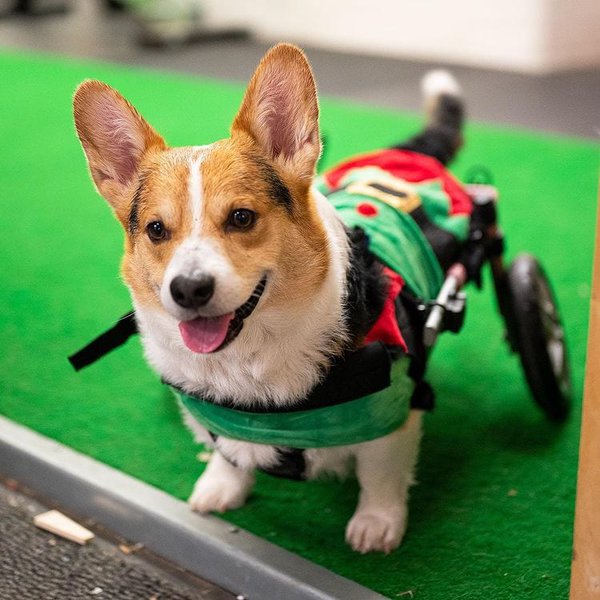
The main factor responsible for IVDD is age. With age, wear and tear from rigorous movement deplete the ligaments, eventually displacing the vertebral discs.
Other factors tend to contribute to the occurrence of IVDD. Below I’ll be explaining them.
Age
As aforementioned, age is the principal cause of IVDD. One mistake is to think that IVDD occurs when the discs dislodge from their regular position.
On the contrary, it begins as soon as the discs begin to get compressed. And age plays a massive role in this. Compression further leads to cracking and then ruptures the inner pulp of the discs.
When your dog moves around by walking or ambling, the intervertebral discs work lightly and don’t get overtasked. But still, they do their work in balancing its body.
Nonetheless, over time, these discs will eventually wear out with use. So, even without being tasked too much, the intervertebral discs will ultimately have issues. So, again, it’s an inevitable factor.
High Level Of Activity
If you have a very active dog, it may develop IVDD faster than other dogs normally. Because the position of the intervertebral discs is critical, they play a very vital role in the stability of your pooch. So, they get strained when your dog gets out of balance.
If your pooch likes to stand on its rear legs and walk upright, that might pose a problem. Or, if it leaps high and jumps around a lot, it can cause its discs to be overly compressed.
In addition, if your pooch only does these tricks and plays too much once in a while, then IVDD might occur slowly. But if it’s a regular habit, then one day, the inner disc pulp might pop out of place and compress the spine.
Breed And Heredity Of Dog
Some certain dog breeds are more susceptible to IVDD than others. For example, Dachshunds are more likely to have IVDD than other dogs.
Scientists have traced this susceptibility to specific genes that these dogs pass on to their offspring. For example, a chromosome — Chromosome 12 — contains a retrogene, FGF4, which, when expressed overly in dogs, tends to cause IVDD.
This gene is mainly present in certain breeds of dogs like Pekingese, Beagles, and Daschunds. Furthermore, in other breeds of dogs that develop IVDD, FGF4 has been found.
Thus, it has been inferred that parents predisposed to IVDD can pass these genes down to their offspring. And these aren’t just Dachshunds and other small dog breeds, but also larger dog breeds like Labradors, Rottweilers, and rarely, German Shepherds.
Size Of Dog
Studies have shown that small dogs have a predisposition to IVDD greater than other dogs. Shih Tzus, Pekingese, Beagles, and Dachshunds have the highest cases of IVDD when compared to other breeds. And one thing is common among them; a tiny stature.
Scientists have tried to connect their height to the condition. The most logical explanation is that their spines are too small. And because of this, they compress their intervertebral discs leading to IVDD in the long run.
Nonetheless, since IVDD still happens in other dogs, and not all small dogs typically suffer from IVDD, I think it’s safe to say that size isn’t a significant cause of IVDD.
How Do I Know My Dog Has IVDD?
It’s pretty easy to diagnose IVDD in dogs, especially when it’s type 3 IVDD. Dogs are suffering from IVDD display symptoms ranging from noticeable swelling on the spine to less detectable ones like peeing issues.
Let’s take a look at the common symptoms of IVDD.
Back Pain
Back Pain is one of the most common symptoms you’d expect if your dog has IVDD. An alteration in the normal position of a critical part of your dog’s back will lead to some discomfort. Whether it even touches vital nerves or not.
Because tissues surround these discs, their displacement would mean a proportionate displacement in these tissues. Tissue cramps are painful and could be the cause of your dog’s back pain.
Something worse that could cause this pain is when a nerve is affected. Pain signals sent to the brain could be disproportionate. Thus, the discomfort could be unnerving, literally.
Inability To Raise Head
When the spine of your dog is affected by displaced discs, its nerves may be affected. The nerve affected depends on which disc was displaced.
If the cranial nerve is affected by a slipped disc, then your dog will lose the ability to move its head. Although it’s an easily diagnosable symptom, this doesn’t mean that it’s not bad.
If your dog cannot move its head, then it won’t be able to feed well. Its breathing pattern would also be affected, and generally, it would be very uncomfortable.
Limping
This list of effects would be incomplete without a limp in the mix. When something is abnormally wrong with your dog’s legs, its gait will change. And one of the causes of a distorted pace is when the motor nerves are not functioning normally.
A dislodged disc could affect the motor nerves significantly when it compresses it.
So, when your dog has a bulge on its back and starts limping, be sure not to rule out IVDD from your suspicions.
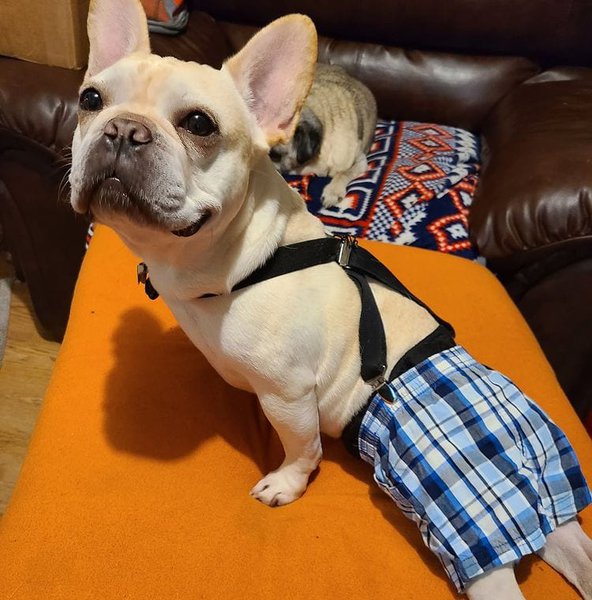
Loss Of Bladder Control
Urinary incontinence is a typical characteristic of spine injury. When the ruptured disc calcifies in a way that affects the spine, then your dog might face problems controlling its pee.
When your canine buddy shows this symptom, it’s best to call for medical care immediately as this issue may require surgery.
Difficulty In Breathing
Most bodily functions are regulated and controlled by critical nerves located on your pup’s spine. So, when these nerves are affected by a sudden disc displacement, they can begin to malfunction or not even function at all.
Respiratory issues arising from IVDD might perhaps be the worst effect of IVDD in dogs. Because if your dog can’t breathe, it will eventually die.
Paralysis
Paralysis is one of the worst effects of IVDD in dogs. Partial or complete nerve obstruction typically causes paralysis in dogs.
So, when the ruptured disc is located in a critical region of your dog’s spine, it may suffer from this. Most times, it’s just the limbs that are affected. But, in other severe cases, complete paralysis can occur.
All three types of IVDD can cause paralysis. But Type 3 is responsible for more cases of paralysis in dogs than others.
What Should I Do If My Dog Has IVDD?
The best thing to do when your dog suffers from IVDD is to give it the care it needs pending your visit to the vet clinic. However, if your dog experiences severe acute IVDD suddenly, perhaps from an injury, then you should call the vet emergency hotline as your dog’s life is in danger.
In many cases, physiotherapy is enough for your dog to recover. So, here are some tips that most vets advise:
Strict Crate-Rest
When your dog has IVDD, it’s best to put it in a position where its spine can readjust to the effects of the sudden compression.
There are special cages designed for dogs to rest in that critical period. You should get one and confine your dog to that space in the meantime.
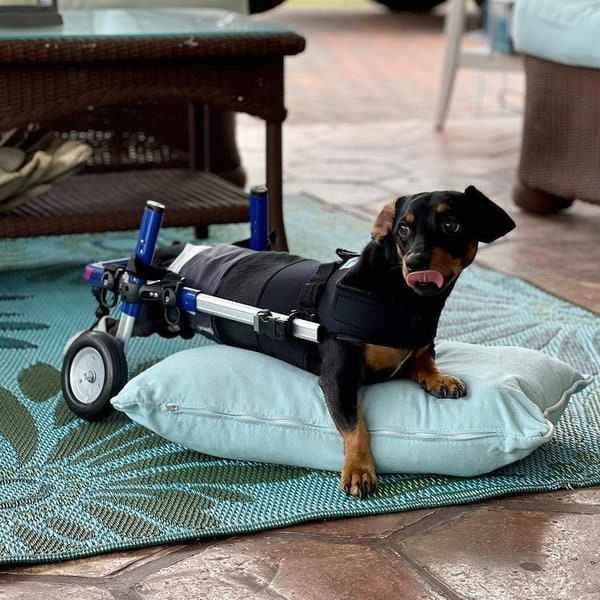
Diet Control
Because your dog will need to be stationary for it to have normalcy and the pain to subside, its metabolism rate will be affected in this state.
So, controlling the amount and kinds of food your dog eats will be essential in keeping its body balanced. Too much food can cause the stomach to put extra weight on the spine. And insufficient food can cause your dog to experience a slow healing process.
Physical Rehabilitation
Your vet may recommend that you do some physical exercises with your dog to ensure it regains its standard physical capabilities. So, it’s beneficial to do these exercises with your dog to speed up its healing process.
Nonetheless, it would be best if you do not do this unless specified by the vet doctor, as you may impose your dog on inappropriate exercises unknowingly.
In addition, most of these physiotherapy processes are specialized, and only highly trained vets can carry them out. So, it’s best to leave this part out for the expert. However, if they recommend any for you to do, it’s best to play your part in the recovery of your furry friend.
How Do You Prevent IVDD In Dogs?
It’s best to use a harness rather than a leash on your dog and stop it from jumping long distances when trying to prevent IVDD.
Nevertheless, as aforementioned, IVDD can’t be curbed completely. You can only take steps to reduce the risk of its occurrence or prevent its effects from being too bad.
There’s no need to be sad, though, as these methods will help reduce the overall pain and the severity of the disease. So, please keep reading as I explain them below.
Using Harnesses
When you use a leash on your dog when walking, it strains its neck, especially when your dog is the adventurous type. For example, if your pooch tends to drag you around when you walk it, the leash will form some resistance on its neck and stress it.
This strain can cause the cervical discs in the neck to eventually slip out. So, it’s best to find an alternative to using a leash, one that spreads the stress around your pooch’s body evenly.
A harness is a perfect alternative to a leash because it doesn’t stress your pup’s neck or spine. Furthermore, it’s more comfortable than a leash.
Using Doggy Stairs
This particular prevention method helps prevent the occurrence of type 3 IVDD specifically. Doggy stairs help prevent your dog from jumping long distances, which causes strain on its spine.
It’s best to place them in strategic places where your dog usually follows, for example, just below tall furniture and stairs. If you have a Daschund or any small breed, doing this will go a long way in preventing it from popping its spine.
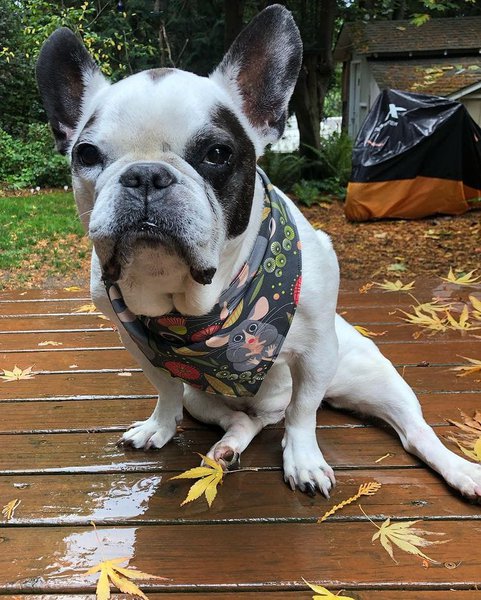
Weight Control
I’ve mentioned diet monitoring as a way of managing your dog when it has IVDD. However, it can play an equally important part in preventing your dog from having the disease.
For example, overweight Daschunds tend to be more predisposed to IVDD than normal-sized ones. Weight from their abdomens usually pressures their spines, eventually leading to slipped discs.
So, managing your canine buddy’s weight will go a long way in preventing it from having the disease.
Regular Physical Examination
Taking your dog to the vet clinic to get examined goes a long way in detecting the onset of the disease. These examinations will help you know how much effort you have to put into preventing the disease.
Furthermore, you’ll also have access to advise from a vet on managing your dog in that critical condition.

